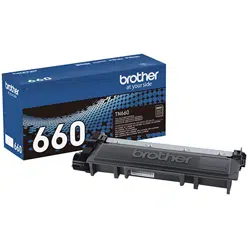Loading ...
Loading ...

BROTHER HL-L2300 SERIES TN630/660 TONER CARTRIDGE REMANUFACTURING INSTRUCTIONS
There is a reset gear that resets the printer each time a new toner cartridge is installed. In our machine, the starter cartridge does
NOT have a reset gear installed. The TN630 and the TN660 cartridges use different reset gears. The TN630 gear has one
black flag, versus two white flags on the TN660. That is how the machine knows if there is a low yield or high yield cartridge
installed. New high yield and super high yield reset gears are available so that starter cartridges can be made into high yield or a
super high yield cartridge. Both the TN630 and TN660 cores are the same, so the low yield can be converted to a high yield if the
proper toner fill and reset gear is used.
Reset gears serve two purposes. First they reset the printer so it knows a new toner cartridge was installed. Secondly they tell the
printer which cartridge was installed. When the printer senses a new toner cartridge, the bias voltage is set to a high voltage.
As the cartridge is used, the bias voltage is gradually reduced. This process is necessary because (according to Brother) a new
toner cartridge has a tendency to print lightly. As the cartridge is used, the density increases. To keep the density level even
throughout its life, the density bias voltage is reduced accordingly. Each time a new cartridge is installed, the bias voltage is reset
to the high voltage point, and the cartridge page count is reset to zero. Since different yields would dictate different decreases in
density over time, Brother uses different reset gears, which tell the printer how fast to reduce the bias voltage.
NOTE: Starting with the HL-6180 series, there were some major changes in the way the toner cartridge AND the drum cartridge
works in this series. In case you missed it, we are covering the theory again...
NEW BROTHER PRINT THEORY
As with previous Brother cartridges, the waste toner is repelled off of the drum to be transferred to the toner unit, but the method
of how this works is now very different.
The waste toner is still transferred to the supply chamber, and this remaining toner MUST still be completely removed from
the supply chamber before adding new toner. Failure to do this will cause backgrounding. In addition to contaminating the
toner cartridge, this may also contaminate the cleaning section of the drum cartridge, which in turn will contaminate the toner
cartridge again. The reasons for this are explained in the following cartridge theory section...
The first new item in this engine is a paper-cleaning roller. This roller cleans off any extra paper dust before the printing process
even begins. It is located just after the paper-feed rollers.
The cleaning section of the drum cartridge no longer consists of a "cleaning brush" and is now a paired system of the cleaning
roller assembly and the transfer roller, but these rollers only play a minor part. The developer roller now has two functions.
In addition to transferring the good toner to the OPC for printing, it now also cleans off the majority of the waste toner from
the drum. This is done by a very complicated series of different electrical charges, and a series of directional changes on the drum
and developer rollers. The developer roller and drum change direction, and charge four times per full drum rotation. This is such a
complicated process that the printers actually have a rotation controller PCB with a microcomputer on it to control it all.
The cleaning roller cleans off any remaining toner that the developer roller did not remove. The transfer roller basically self-cleans
itself of any residual toner or paper dust that might have accumulated in the printing process.
When the drum is cleaned by the transfer roller the surface potential of the drum is dropped (from 900V to about 200V). At this
point the transfer roller and cleaning roller will release the waste toner to the drum. This waste toner is actually then charged by
the corona wire so that the developer roller can pick it up and bring it back into the toner hopper. Both rollers release the waste
toner at the same time. This was done to keep the print speed high, the power supply low, and the cost of the two rollers and
cartridges down.
The drum unit also now has a small waste chamber next to the cleaning roller. The reason for this waste area is for things such as
paper dust that does not transfer well. Since there is a paper-cleaning roller before the cartridges in the printer, this area in theory
should stay fairly empty. The metal roller next to the cleaning roller helps keep the cleaning roller free of anything that does
not transfer.
Since the developer roller now does most of the cleaning work, the condition of the roller while always important, is now much
more so. If the roller has any contamination on it from the toner additives (OEM or aftermarket), it will interfere with the cleaning
cycle and ghosting/backgrounding will result. If the cleaning roller gets contaminated and not cleaned properly the same problem
will result. The main culprit for this used to be the charge felt. It is now the developer roller. It is very important that the developer
roller be cleaned with a dedicated developer roller cleaner. Never use alcohol of any type, as this will strip the conductive coating
off the roller.
© 2015 UniNet Imaging Inc. All trademark names and artwork are property of their respective owners. Product brand names mentioned are intended to show compatibility only.
UniNet Imaging does not warrant downloaded information. Unauthorized sale, reproduction or distribution of this article is prohibited. For additional support, please contact [email protected]
www.uninetimaging.com
Loading ...
Loading ...
Loading ...
